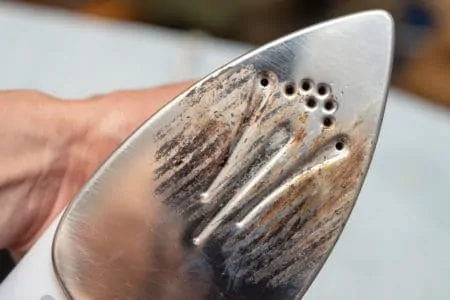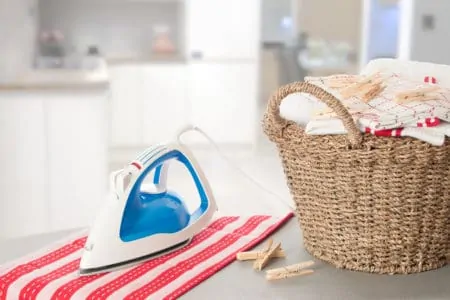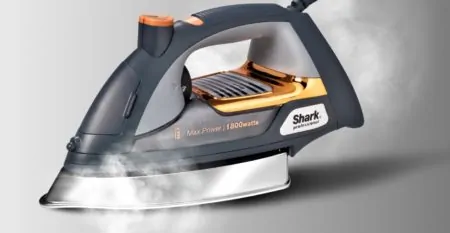When was the last time you cleaned your iron? It might be due a good scrub and clean.
It’s important that you keep your iron clean and fresh so that it has the same effect on your clothes. We’ll teach you how to clean your iron in a few different ways. You’ll be sure to find the best way for you, using the materials you have on hand.
Key Takeaways
- Sprinkle salt: Sprinkle salt over a sheet of paper.
- Iron: Set the iron to warm and iron over the salty paper. The grains of salt will help to remove stains and grime.
- Unplug: Unplug the iron and let it cool.
- Wipe: When the iron is cool, wipe a dry cloth over the soleplate.
Signs Your Iron Needs Cleaning
Have you never cleaned your iron — like ever? Don’t worry, you’re not alone. But here are some sure signs that your iron is begging to be cleaned.
- Your iron coughs out chalky white substance or limescale: Your iron is due for a clean if you notice it leaving these horrid stains on your beautiful clean clothes.
- Sticky substance melts onto the soleplate: Sticky residue clings to irons from starch spray or melting synthetic fabrics. The stickiness melts onto the soleplate and transfers onto the clothes.
- The iron drags: If the iron drags instead of glides, it’s time for a clean.
- It leaves marks and stains: The last thing you want when ironing is to ruin your clothes. If your iron has left behind unfortunate marks or stains, then follow our tips for cleaning an iron!
How to Clean an Iron
There are a lot of different ways to clean irons. Every single one works for different things, so be sure to check out every method to find the best way for your situation. Following these steps will deliver you a sparkling clean iron that gives you crisp, fresh clothes again!
Method #1: Salt
Why Salt?
Salt is great for making stains and gunk disappear. It’s also useful since we all have salt in the cupboard! Scientifically, salt is known as sodium chloride which is great at absorbing sticky and greasy textures, like the gunk on your iron (1).
What You Need
- Salt.
- Paper.
- Soft cloth.
Instructions
- Sprinkle salt: Sprinkle a generous amount of salt over a sheet of paper.
- Iron: Set the iron to warm and iron over the salty paper. The grains of salt will help to remove stains and grime.
- Unplug: When you’re satisfied, unplug the iron and let it cool.
- Wipe: When the iron is cool, wipe a dry soft cloth over the soleplate.
Method #2: Toothpaste
Why Toothpaste?
We recommend toothpaste if you’re getting rid of soleplate gunk. It’s a super easy way to get your iron clean. Toothpaste commonly is made with baking soda, which has natural cleaning properties. It’s also a mild abrasive which can help scrub away gunk on your iron (2).
What You Need
- Toothpaste.
- Damp cloth.
- Old towel.
- Water.
Instructions
- Prepare your iron: Make sure your iron is unplugged, cooled down and the water tank is empty.
- Apply toothpaste: Rub the toothpaste — any brand — onto the dirty areas of the iron.
- Wipe away: Use your damp cloth to wipe away the toothpaste.
- Fill the iron: Fill the water tank with water and turn the iron back on.
- Let it steam: Put the iron on top of an old towel and set it to steam. Leave it for five minutes. Now you have a clean iron — voila!
Method #3: Baking Soda
As if you needed another reason to keep baking soda nearby, it’s also awesome for cleaning an iron.
Why Baking Soda?
We love baking soda for getting rid of gunk and grime on your iron’s soleplate. This alkaline substance is wonderful for cleaning, and anti-bacterial properties (3).
What You Need
- Baking soda.
- Distilled water.
- A small bowl.
- Microfiber cloth.
- Cotton swabs.
Instructions
- Make a paste: Combine two parts baking soda with one part water in your small bowl. Mix until you’ve made a paste.
- Spread: Make sure your iron is unplugged and cool before you spread the paste over the soleplate.
- Wipe clean: Use your microfiber cloth to wipe the paste away, removing all of it. We recommend a microfiber cloth because it doesn’t leave any lint behind.
- Use the cotton swab: Dip the cotton swab into some distilled water. Use it to clean the holes on the soleplate.
- Let it dry: Let the iron dry completely before using it again.
Method #4: White Vinegar
Why White Vinegar?
White vinegar gives a thorough clean of the soleplate, including grime and gunk. But it’s also amazing for descaling the inside of your iron. White vinegar is very acidic, which gives it the power to dissolve dirt, grease, grime and mineral deposit (4).
What You Need
- Distilled white vinegar.
- A clean cloth.
- Water.
- Cotton swab.
- Pouring jug.
Instructions for Soleplate
- Mix: Mix together equal parts water and vinegar.
- Clean: Dampen the cloth using the solution. Clean the dirty areas of your soleplate with the cloth.
- Fill the tank: Fill the tank with water and turn your iron on.
- Steam: Place the iron on top of a clean cloth or old towel and let it steam. Let it sit for five minutes.
Method #5: Vinegar and Baking Soda
Why Vinegar and Baking Soda?
When you mix vinegar and baking, you basically get something called sodium acetate (5). Sodium acetate is useful for removing grease, without damaging your iron and therefore your clothes.
What You Need
- Baking soda.
- Distilled white vinegar.
- Towel.
Instructions
- Make a solution: Mix two teaspoons of baking soda and vinegar together to form a solution. We should warn you — it will fizz quite a bit at first, but it calms down.
- Soak a towel: Soak a towel in the solution. Lay it flat.
- Clean the iron: With the iron turned off, run the iron over the soaked towel as if you were ironing it. This will get rid of stubborn stains.
Method #6: Salt and Vinegar
Why Salt and Vinegar?
Salt and vinegar isn’t only for chips by the seaside. You can also use it to get rid of those ugly scorch marks on your iron. Salt and vinegar is an acidic solution that is really good at getting rid of metal oxides (6).
What You Need
- Salt.
- Distilled white vinegar.
- Pot.
- Stove.
- Cloth.
- Old towel.
Instructions
- Mix: Mix together two parts vinegar and one part salt in a pot.
- Heat up: Heat up this mixture until the salt has dissolved, but don’t let it boil.
- Let it cool: Let the mixture cool down.
- Clean: Dip a clean cloth into the mixture and clean the metal plate. Scrub at the stains. This should remove scorch marks and other grime.
- Turn on the iron: Fill the iron with water and turn it on.
- Steam: Put the iron on top of an old towel and let it steam for five minutes. You’ll be left with a sparkling clean iron!
Method #7: Acetone Nail Polish Remover
Why Acetone?
Acetone is a common solvent that is used to dissolve other compounds (7). That’s why we love this method for getting rid of general dirtiness on your iron. It will help to dissolve gunk so that you can easily wipe it away.
What You Need
- Acetone nail polish remover.
- Cotton balls or wipes.
- Oven mitts.
- Water.
- A cloth.
Instructions
- Turn on the iron: Turn on your iron and let it heat up.
- Soak cotton ball: Soak your cotton ball or wipe in the acetone nail polish remover.
- Clean: Wear your oven mitts here so you don’t get burned. Dab at the soleplate with your soaked cotton ball. Beware because the acetone evaporates quickly so you might need to repeat a few times.
- Wipe: When you’re done, wipe the soleplate with a damp cloth.
Method #8: Dish Detergent
Why Dish Detergent?
You’ve probably always got dish detergent in the house, so might as well put it to use where you can! This is ideal for removing residue on your iron’s soleplate. Dish soap acts as an emulsifier, which helps break down grease and help cut grime (8).
What You Need
- Dish detergent.
- Soft cloth.
- Water.
- Bowl.
Instructions
- Make a solution: Fill a bowl with water and add a few drops of dish detergent. Mix well.
- Clean: Dip the soft cloth into the water and wipe it over a cool, unplugged iron.
Method #9: Kitchen Sponge and Scubbers
Another thing we all have in the house — so let’s use them for the iron as well.
Why Kitchen Sponge and Scubbers?
The abrasive texture of sponges and scrubbers can help remove gunk, grime and residue.
What You Need
- Non-scratch kitchen sponge or scrubber.
- Soap.
- Water.
- Towel.
Instructions
- Mix a solution: Mix together a solution of soap and water.
- Scrub: Soak the sponge or scrubber in the water and scrub the iron’s soleplate. Do this until it’s clean.
- Wipe: Wipe the surface with a towel and let it dry completely before you use the iron.
Method #10: Dryer Sheets
Why Dryer Sheets?
Dryer sheets work a treat when you need to remove gunk and dirt from your iron. Dryer sheets are abrasive enough to scrub away dirt and gunk. The fabric softening agents in the dryer sheet also help to loosen gunk and dirt (9).
What You Need
- Dryer sheets.
- Old towel.
Instructions
- Turn your iron on: Turn your iron onto the lowest heat setting.
- Rub: Gently rub the iron plate with the dryer sheets until the gunk and dirt is all gone.
- Turn up the heat: Set the iron to the hottest setting and iron an old towel to remove any residue from the dryer sheets.
Method #11: Newspaper
Why Newspaper?
Newspapers are a handy thing to use to clean your iron. It can help to clean your iron from sticky substances, because newspapers don’t contain solid scratching materials. They will not separate or leave behind yucky lint (10). So you can scrub, scrub, scrub to clean your iron!
What You Need
- Newspaper.
- Oven mitts.
Instructions
- Heat up the iron: Turn your iron onto the hottest setting.
- Wear oven mitts: This will protect you from getting burned.
- Clean: Scrunch up some newspaper. The more you use, the more vigorously you can scrub without ripping the paper. Rub the soleplate until it’s clean.
Tips for Iron Maintenance
Your iron should last a really long time, but this is only possible if you take good care of it. Here are some tips to properly keep your iron in tip-top condition.
- Use distilled water when possible. It is free from minerals that can cause limescale build-up in your iron.
- Empty the water reservoir after each use of your iron. This also helps prevent limescale build-up.
- Always let the iron cool down completely before putting it away. Wipe down the soleplate every time with a microfiber cloth. This helps to remove residue and dirt that might have transferred from your clothes.
- Clean your iron frequently. It’s easy to clean an iron, so there’s no reason why you shouldn’t do this regularly.
- Clean out those steam holes. Steam holes can get clogged up quite easily and ruin the function of your iron. Clean them out with a cotton swab every time you clean your soleplate.
FAQs
We’re here to answer the most commonly asked questions about cleaning an iron.
Keep It Clean
Keep your iron clean for the best ironing results. Cleaning your iron is a super satisfying job. We recommend you do it frequently, especially if you iron every week!
Make sure to use the best method for the stains on your iron. If you’re removing gunk, use toothpaste or salt. If you’re getting rid of scorch marks, try salt and vinegar. If you need to descale your iron, distilled white vinegar will do the trick.
After this, if there’s a contest for the cleanest iron, you’ll definitely win.













